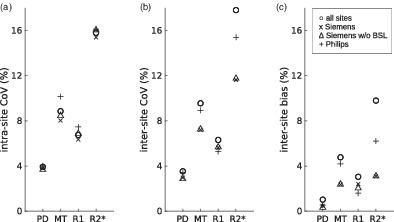当前位置:
X-MOL 学术
›
Hum. Brain Mapp.
›
论文详情
Our official English website, www.x-mol.net, welcomes your feedback! (Note: you will need to create a separate account there.)
Multiparameter mapping of relaxation (R1, R2*), proton density and magnetization transfer saturation at 3 T: A multicenter dual-vendor reproducibility and repeatability study.
Human Brain Mapping ( IF 4.8 ) Pub Date : 2020-07-08 , DOI: 10.1002/hbm.25122 Tobias Leutritz 1 , Maryam Seif 1, 2 , Gunther Helms 3 , Rebecca S Samson 4 , Armin Curt 2 , Patrick Freund 1, 2, 5, 6 , Nikolaus Weiskopf 1, 7
Human Brain Mapping ( IF 4.8 ) Pub Date : 2020-07-08 , DOI: 10.1002/hbm.25122 Tobias Leutritz 1 , Maryam Seif 1, 2 , Gunther Helms 3 , Rebecca S Samson 4 , Armin Curt 2 , Patrick Freund 1, 2, 5, 6 , Nikolaus Weiskopf 1, 7
Affiliation

|
Multicenter clinical and quantitative magnetic resonance imaging (qMRI) studies require a high degree of reproducibility across different sites and scanner manufacturers, as well as time points. We therefore implemented a multiparameter mapping (MPM) protocol based on vendor's product sequences and demonstrate its repeatability and reproducibility for whole‐brain coverage. Within ~20 min, four MPM metrics (magnetization transfer saturation [MT], proton density [PD], longitudinal [R1], and effective transverse [R2*] relaxation rates) were measured using an optimized 1 mm isotropic resolution protocol on six 3 T MRI scanners from two different vendors. The same five healthy participants underwent two scanning sessions, on the same scanner, at each site. MPM metrics were calculated using the hMRI‐toolbox. To account for different MT pulses used by each vendor, we linearly scaled the MT values to harmonize them across vendors. To determine longitudinal repeatability and inter‐site comparability, the intra‐site (i.e., scan‐rescan experiment) coefficient of variation (CoV), inter‐site CoV, and bias across sites were estimated. For MT, R1, and PD, the intra‐ and inter‐site CoV was between 4 and 10% across sites and scan time points for intracranial gray and white matter. A higher intra‐site CoV (16%) was observed in R2* maps. The inter‐site bias was below 5% for all parameters. In conclusion, the MPM protocol yielded reliable quantitative maps at high resolution with a short acquisition time. The high reproducibility of MPM metrics across sites and scan time points combined with its tissue microstructure sensitivity facilitates longitudinal multicenter imaging studies targeting microstructural changes, for example, as a quantitative MRI biomarker for interventional clinical trials.
中文翻译:

3 T 时弛豫(R1、R2*)、质子密度和磁化转移饱和度的多参数映射:多中心双供应商再现性和可重复性研究。
多中心临床和定量磁共振成像 (qMRI) 研究需要跨不同站点和扫描仪制造商以及时间点的高度可重复性。因此,我们实现了基于供应商产品序列的多参数映射 (MPM) 协议,并展示了其对全脑覆盖的可重复性和再现性。在约 20 分钟内,使用优化的 1 mm 各向同性分辨率协议在 6 个 3来自两个不同供应商的 T MRI 扫描仪。同样的五名健康参与者在每个站点在同一个扫描仪上进行了两次扫描。使用 hMRI 工具箱计算 MPM 指标。为了考虑每个供应商使用的不同 MT 脉冲,我们线性缩放 MT 值以在供应商之间协调它们。为了确定纵向可重复性和站点间可比性,估计了站点内(即扫描-重扫描实验)变异系数 (CoV)、站点间 CoV 和站点间偏差。对于 MT、R1 和 PD,站点内和站点间的 CoV 跨站点和扫描时间点的颅内灰质和白质介于 4% 到 10% 之间。在 R2* 图中观察到较高的站点内 CoV (16%)。所有参数的站点间偏差均低于 5%。总之,MPM 协议以高分辨率和较短的采集时间产生了可靠的定量图。
更新日期:2020-07-08
中文翻译:

3 T 时弛豫(R1、R2*)、质子密度和磁化转移饱和度的多参数映射:多中心双供应商再现性和可重复性研究。
多中心临床和定量磁共振成像 (qMRI) 研究需要跨不同站点和扫描仪制造商以及时间点的高度可重复性。因此,我们实现了基于供应商产品序列的多参数映射 (MPM) 协议,并展示了其对全脑覆盖的可重复性和再现性。在约 20 分钟内,使用优化的 1 mm 各向同性分辨率协议在 6 个 3来自两个不同供应商的 T MRI 扫描仪。同样的五名健康参与者在每个站点在同一个扫描仪上进行了两次扫描。使用 hMRI 工具箱计算 MPM 指标。为了考虑每个供应商使用的不同 MT 脉冲,我们线性缩放 MT 值以在供应商之间协调它们。为了确定纵向可重复性和站点间可比性,估计了站点内(即扫描-重扫描实验)变异系数 (CoV)、站点间 CoV 和站点间偏差。对于 MT、R1 和 PD,站点内和站点间的 CoV 跨站点和扫描时间点的颅内灰质和白质介于 4% 到 10% 之间。在 R2* 图中观察到较高的站点内 CoV (16%)。所有参数的站点间偏差均低于 5%。总之,MPM 协议以高分辨率和较短的采集时间产生了可靠的定量图。



























 京公网安备 11010802027423号
京公网安备 11010802027423号